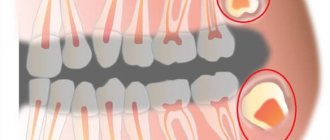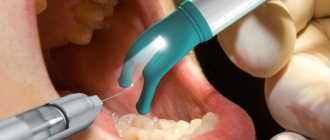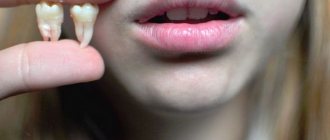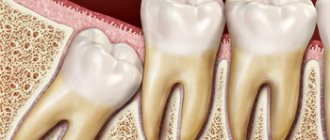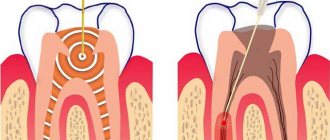Removal of wisdom teeth due to caries
Why are wisdom teeth most often affected by caries?
Most often, caries of wisdom teeth develops due to the fact that they are located far enough away and do not participate in the act of chewing.
And if the teeth are not involved in the act of chewing, then it is extremely difficult to clean them due to the fact that the teeth are cleaned not only during hygiene, but also during each meal - on their own. On the picture
– what caries looks like on the bottom eight.
You can see how the lower wisdom tooth is removed due to caries HERE. By the way, there, in clinical cases, you can see how the removal of an upper wisdom tooth occurs.
Often the patients themselves neglect these teeth, brush the eights less carefully and caries develops quite quickly, the wisdom tooth begins to hurt, so it will be easier to remove such a tooth than to treat it.
Can caries cause wisdom tooth removal?
Should wisdom teeth with caries be removed? Yes. Removal of the figure eight, if there is caries, is carried out due to the inappropriateness of its treatment.
In most cases, we do not chew with these teeth, and treating wisdom teeth is quite difficult and problematic. And most importantly, this makes absolutely no sense.
Removing the bottom eight can be seen HERE
There is also a situation when the wisdom tooth is strongly inclined, “lying” and covered with caries. In this case, there is also absolutely no point in treating wisdom teeth.
.
If your wisdom tooth gets injured: chipped or cracked?
Should it be removed? A chip, crack, or injury to a wisdom tooth is a 100% indication for removal
wisdom tooth There is absolutely no reason to fight to save him.
Wisdom teeth during orthodontic treatment
Removal of wisdom teeth before orthodontic treatment
During the period of orthodontic treatment, when the bite is being corrected, the figure eights are also most often removed. Why?
Before orthodontic treatment, we need to remove teeth that are preventing all the remaining teeth - 28 teeth - from moving into place. As a rule, wisdom teeth do not provide freedom for such activities. We remove them and then perform orthodontic treatment.
In what cases are wisdom teeth not removed during orthodontic treatment?
In the case of large jaws, when the wisdom teeth are in an absolute row and they close correctly, in the correct occlusion, we do not need to remove them. We can leave them, we can also treat them, take care of them, like other teeth.
Impacted and dystopic wisdom teeth
Impacted wisdom tooth
- this is a tooth that has not erupted; it is located in the bone tissue, in the gum. The general practice is that few dentists decide to remove an impacted figure eight, since it is a complex procedure.
In the clinics of the German Implantology Center, removal of impacted wisdom teeth is carried out as planned; our experience allows us to perform surgery of this level.
Why don't wisdom teeth erupt?
The wisdom tooth does not erupt due to the fact that it is dystopic: there is a neighboring tooth in front of it, which is in the way.
This wisdom tooth is usually tilted. Or there is absolutely no room in the jaw, it is located at the corner of the jaw: there is no place for it to cut through, there is no way.
Dystopic tooth
A wisdom tooth is a tooth that is erupting or has erupted incorrectly. Or it cannot erupt and occupies the wrong position in the jaw.
Typically, such teeth displace other teeth, deforming the jaw. It is impossible to treat them, and straightening them is also extremely difficult. In these cases, we remove the dystopic wisdom tooth. As a result of dystopia, cheek injuries may also occur due to chronic biting. Therefore, it is better not to postpone the removal of the dystopic eight “for later”.
Why are impacted teeth problematic?
What teeth are called impacted? These are units that, for certain reasons, did not cut through. In most cases, the “eight” is such a tooth, since it erupts quite late and by that time there is no free space in the jaw.
Considering that such teeth are not involved in the process of chewing food and at the same time become the cause of inflammation in the future, it would be more advisable to remove them.
The difficulty of removing an impacted tooth is explained by the fact that in order to open access to them it is necessary to disrupt the integrity of the gums due to its inconvenient location. The procedure can last up to an hour or longer.
Extraction procedure
The stages of removing an impacted tooth are as follows:
- an incision is made on the gum;
- the surgeon drills a hole in the bone;
- the problematic tooth is pulled out;
- all remaining bone fragments are removed from the socket;
- the wound is treated with an antiseptic solution;
- stitches are placed.
Immediately after the procedure, it is advisable to apply cold to the cheek, which accelerates the formation of a blood clot. This will prevent the wound from becoming infected. If necessary, the doctor may also prescribe anti-inflammatory drugs.
Removal of wisdom teeth in pregnant and lactating women
Removal of wisdom teeth in pregnant and nursing mothers
Is it possible to remove wisdom teeth during pregnancy? Pregnant and lactating women can have their wisdom teeth removed only in case of exacerbation of one of them or necessity, when it is impossible to solve this problem conservatively. In a planned manner, it is better to remove wisdom teeth after the end of the feeding period.
Are there any special features of removing wisdom teeth during pregnancy?
We try to perform tooth extraction on all our patients as carefully, comfortably, and carefully as possible. Therefore, as a rule, there are no technical features. But if any intervention in the form of wisdom tooth removal is urgently required (because there is no other alternative), we must consult with the attending physician - a gynecologist and, accordingly, coordinate all our actions.
What anesthesia is used when removing wisdom teeth in pregnant and lactating women?
In pregnant and lactating women, after consultation with a gynecologist, we, as a rule, perform anesthesia with a reduced level of adrenaline, so as not to provoke the onset of labor in the later stages, and not to provoke a miscarriage in the early stages.
Wisdom teeth: what is the difficulty of removing them?
If we are talking about the extraction of a wisdom tooth, then the complexity of the manipulation is explained by its very location in the dentition. Wisdom teeth are considered problematic because they:
- erupt much later than others;
- often grow with a bias to the side, thereby disturbing the evenness of the dentition;
- They react differently to surgical intervention: pronounced swelling of the gums appears, body temperature rises, and pain is much more intense.
Typically, such complications go away within a few days, provided proper care of the socket and oral cavity is performed.
Removal of a wisdom tooth near the maxillary sinus
If the wisdom tooth is located near the maxillary sinuses, there is a certain difficulty in such removal. Why?
If a wisdom tooth is located close to the maxillary sinus, there is a risk that during removal the tooth can be pushed into the maxillary sinus. If you make incorrect technical movements when removing a tooth, or work roughly in some way, you can harm the person and, accordingly, you will then need expensive long-term treatment to remove this tooth.
Are there any specifics to removing wisdom teeth?
Of course, there are some peculiarities when removing wisdom teeth. The doctor’s task is to make the removal process as accurate as possible, as atraumatic as possible - in principle, like the rest of the teeth. But in the case of a wisdom tooth, there are some peculiarities of anatomy.
The peculiarities are that the figure-eight tooth is located quite far away and quite well hidden. But at the same time, using modern equipment, modern materials and having experience, you can remove wisdom teeth quickly and accurately enough without consequences or injuries.
In what cases is dental surgery difficult?
Complex manipulations regarding tooth extraction include the following situations:
- with disconnected roots that are excessively curved inward or directed in different directions;
- when the problem tooth is located in the affected bone;
- in the complete absence of a crown, when there is nothing to grab onto with forceps;
- if a filling was previously installed in the tooth, which can crack under the mechanical influence of forceps;
- when the tooth is impacted or dystopic;
- removing the "eight"
These are the main clinical features in which it is impossible to get rid of a diseased tooth using a standard simple procedure. Moreover, in each specific case the reasons for complex extraction may be individual.
Competent removal of wisdom teeth
How to remove a wisdom tooth in the least traumatic way?
The wisdom tooth is removed atraumatically after carefully evaluating the computed tomography scan, talking with the patient, and assessing his clinical case. The tooth is separated - divided into parts if it has any bends, slopes, or several roots. And, accordingly, with the help of elevators, luxators - special dental instruments, it is carefully and carefully dislocated.
There is no need to worry about the appearance of some blood after wisdom tooth removal. The removal is carried out under the full supervision of a doctor; the wound after tooth extraction is sutured and sutures are applied. What follows is a standard rehabilitation protocol without any surprises for the patient. The only thing is that after the removal of a wisdom tooth (wisdom teeth), swelling of the mucous membrane is possible.
Why is atraumatic tooth extraction more preferable?
With this removal, the doctor takes care of the health of the patients. So that the healing takes place as comfortably as possible, so that there are no consequences after this, so that the patient in the near future, after 7-10 days, forgets that he had his wisdom tooth removed. It is after this time that possible swelling and pain after removal are completely removed.
Pain after wisdom teeth removal
How long does pain last after wisdom tooth removal?
Pain after the removal of wisdom teeth lasts differently, depending on the sensitivity of the person and how the healing proceeds in general. It hurts after removing the figure eight from several days to, maximum, 7-10 days. Naturally, all pain, all painful symptoms from wisdom tooth removal subside over time.
What should you do if the wound hurts for a long time after wisdom tooth removal?
If you experience prolonged pain after wisdom tooth removal, you should contact your doctor as soon as possible, and he will adjust his prescriptions. If any problems arise, he will solve them.
In the first 2-3 days you cannot:
- Remove medications that the doctor placed in the socket of the extracted tooth.
- Touch the place where the tooth used to be with your tongue, fingers, or something else.
- Take solid or hot food, it is better to eat it in liquid form - soups, purees.
- Rinse your mouth on the first day after removal.
- Drink alcohol.
- Smoking.
- Chew on the side of the extracted tooth.
- Overheat or overcool the site of tooth extraction.
- Do physical activity, visit the pool, sauna and play sports.
When should wisdom teeth not be removed?
What can serve as a contraindication to wisdom tooth removal? A contraindication to wisdom tooth removal may be a person’s health condition, as a result of which we cannot subject him to such a surgical intervention.
For example, if the patient suffers a heart attack in the near future, within six months. Or he has some kind of uncompensated disease. In these cases, we first prepare the patient, consult with related specialists, and after that, as planned, we carry out removal procedures.
Cases when complex surgery is necessary
It often happens that the only possible way to get rid of a defect formed by a complex tooth is to remove it.
Indications for this type of procedure are as follows:
- the formation of periodontal tumors and edema, accompanied by soreness of the mucous membranes and gums;
- numbness of the face resulting from damage to the nerve endings of a diseased tooth;
- with an increased risk of curvature of adjacent teeth;
- in the presence of diseases caused by improper positioning of the tooth.
Surgeries to remove problematic teeth are contraindicated for those who suffer from pathologies of the cardiovascular system, with poor blood clotting, patients who have undergone a hypertensive crisis, in the presence of infectious or viral processes in the body, as well as other individual contraindications.
Complications after wisdom tooth removal
What may be the cause of complications after removal of figure eights?
Complications after removing the figure eight - yes, they exist. Complications are different: they occur directly during the removal procedure, there are delayed ones, blood vessels may be damaged, and bleeding may occur. There may be a fracture of the jaw, a breakage of a section of bone tissue that is located in close proximity to the wisdom tooth.
Long-term complications – for example, wound infection in the case of unsterile instruments. If the doctor did not warn the patient that he needs to take antibiotics prophylactically for an impacted wisdom tooth.
What are the complications after wisdom tooth removal?
After the removal of a wisdom tooth, there are complications of different etiologies: they can either arise immediately or be delayed. Bleeding may immediately occur, your jaw may break, a piece of bone may break off (both small and large) - then your jaw will begin to hurt. You can tear the mucous membrane, injure a neighboring tooth, break a neighboring tooth, etc. Your gums or throat may begin to hurt.
Delayed complications are oral infection, periostitis, alveolitis, inflammation of bone tissue.
Can the temperature rise after wisdom tooth removal?
After the removal of a wisdom tooth, the temperature may rise in people who are very nervous or have suffered a lot of stress. This will be a vegetative-vascular reaction, and once the temperature can rise to 38.5-39 degrees. Once. It can be brought down by the use of antipyretic drugs and, accordingly, it should no longer be present. There may be a low-grade fever of 37 degrees, 37.1-37.2, for several days after removal. This does not have any consequences, this is normal, but you should, of course, inform the doctor about this so that he takes this fact into account and adjusts his prescriptions.
Can gumboil appear after wisdom tooth removal?
After wisdom tooth removal, gumboil may appear. This can happen as a result of a wound becoming infected. For example, the use of non-sterile instruments, non-sterile materials. This can also be a result of the removal of an impacted wisdom tooth, for example, if the doctor “sutured it in tightly”, and there are a lot of bacteria in our oral cavity, and did not prescribe antibiotic prophylaxis. In this case, flux is likely to occur.
Preparing for surgery
- Beforehand, have your mouth professionally cleaned by a dental hygienist to avoid infecting the surgical wound. If there are purulent processes, this is not even a recommendation, but a strict requirement.
- Do not drink alcohol or smoke for at least 24 hours before surgery.
- Do not take a hot bath or visit a bathhouse or sauna on the day you plan to remove the tooth and the day before.
- Before surgery, refrain from sports and intense physical work for a day or two.
Dry socket syndrome during wisdom teeth removal
Dry socket syndrome in wisdom teeth
The wisdom tooth refers to the concept of dry socket, or more precisely, dry socket syndrome. A dry tooth socket is alveolitis. Dry socket syndrome after the removal of figure eights can occur in this area, especially in the area of the lower wisdom teeth due to the fact that as a result of swallowing, as a result of opening the mouth, muscles tense, which aggravate the occurrence of alveolitis.
What can dry socket syndrome lead to and what to do?
A dry socket after the removal of figure eights can lead to very severe pain that radiates to the temple and ear. This is a very great torment: a person cannot, even if he is not sensitive, he cannot tolerate it, he will definitely take painkillers 4-5 or 6 tablets. And as a result of this, he will still go to the dentist. A dry socket, if it has formed after removal, will not go away on its own. Alveolitis can only get worse - up to inflammation of the jaw. There may be dire consequences.
Consequences after extraction of a complex tooth and possible complications
Patients who are about to have a complex tooth removed should be prepared for the fact that tissue restoration will be quite long. If we talk about the consequences, the most dangerous among them is inflammation of the alveoli.
Its first symptoms appear approximately 2-3 days after surgery. Initially, severe swelling appears, which gradually spreads throughout the face. An unpleasant putrid odor is felt from the mouth, and the body temperature rises.
The primary cause of such inflammation is improper care and ignoring doctor’s recommendations. Alveolitis can also be caused by root fragments remaining in the hole, which the doctor performing the procedure did not remove due to his carelessness.
If you observe signs indicating the development of an inflammatory process, you should immediately contact your dentist. To prevent such complications from arising, such dental surgery should be performed only by an experienced surgeon.
The Berezka dental clinic employs certified, experienced and responsible dentists who are able to carry out the most complex tooth extraction with minimal risks of subsequent complications.
Recommendations after wisdom tooth removal
What medications should you take after wisdom tooth removal?
The following medications are used after wisdom tooth removal: painkillers, mouth rinses - special, with a strong antiseptic content. Often, an antibiotic is prescribed as therapy after the removal of the figure eight, and we also prescribe probiotics to restore the intestines after taking antibiotics.
Recommendations after wisdom teeth removal
In general, the recommendations are the same as in the case of removing simple teeth. But they should be performed more carefully.
Physical exercise
–
exclude
. Try not to disturb the extraction site, because the wisdom tooth is located in an awkward/unfortunate area where swallowing and opening the mouth will affect the surgical site.
Of course, wisdom tooth removal is incompatible with subsequent alcohol consumption for several days. Smoking is also strictly not recommended.
Brushing your teeth after wisdom tooth removal
Is it necessary to brush your teeth after wisdom tooth removal or can you wait a few days? You should definitely brush your teeth after removing a wisdom tooth. This needs to be done quite carefully, but at the same time carefully. It is not recommended to rinse your mouth after wisdom tooth removal. That is, the question “what to rinse your mouth with” in this case disappears. Using an irrigator is also not recommended.
Tooth extraction
Modern surgical dentistry allows, in most cases, to avoid tooth extraction. But, if a diseased tooth poses a threat to healthy ones, then the procedure is inevitable. The operation is performed under local anesthesia and takes up to 40 minutes. The dentist extracts the tooth along with its roots using forceps. If indicated, the doctor can use a dental bur to divide the tooth into parts and remove them separately.
When is tooth extraction necessary?
Indications for tooth extraction:
- A frequent indication for surgery is the need for sanitation of the oral cavity in the presence of chronic periodontitis in the acute stage, when it is impossible to eliminate the inflammatory focus at the apex of the tooth
- Removal is also carried out in order to avoid more serious complications. For example, in the presence of teeth that can cause a cyst, inflammation or neuritis of the trigeminal nerve
- If a tooth constantly injures the tongue or the mucous membrane of the cheek, interferes with a normal bite, if orthodontic treatment is impossible
- For extensive caries, when therapeutic or orthopedic restoration is impossible
- Teeth that are incorrectly positioned or have not fully erupted must also be removed.
How to prepare for tooth extraction? Is it painful?
Before the operation, the dental surgeon prescribes an X-ray examination (3D dental computed tomography) to the patient, studies the condition of diseased teeth, adjacent healthy teeth, and the location of their roots. Before removal, the patient is given an anesthetic by injection. Before the injection, an anesthetic gel is applied to the gums, so discomfort is minimized.
What to do after tooth extraction?
After the operation itself, no specific actions are required from the patient. It is advisable not to eat for 3 hours, not to touch the hole with your tongue and not to rinse your mouth.
To prevent subsequent displacement of adjacent teeth, it is advisable to install a denture. Even one missing tooth causes a redistribution of the chewing load and can lead to bone atrophy and displacement of adjacent teeth. Installing a dental implant helps avoid these changes. Sometimes an implant can be installed immediately after removal—simultaneous implantation. If the tooth extraction was associated with inflammation, then you should wait for the wound to heal and then install implants. In each specific case, the dentist will suggest the best methods of further treatment.
Removing 2 wisdom teeth at the same time
Removal of two wisdom teeth from one side of the jaw. Pros and cons of this approach.
Two teeth at once on one side is a very good technique. In this case, we immediately remove two teeth and the healing process takes place only once. Accordingly, the pain also disappears once. The healing is in no way burdened by the fact that we remove two of them at once. It’s a good, even excellent approach, and that’s what we do in most cases if the patient doesn’t mind.
An example of removing two wisdom teeth at once - HERE
Dystropic tooth: indications for removal
A tooth with an incorrect location in the dentition relative to its neighbors is called dystrophic. It can take the place of another, spontaneously turn, change the angle of growth, which significantly interferes with neighboring teeth and leads to the formation of a malocclusion.
Indications for extraction of a dystrophic tooth are:
- swelling of the gums and pain;
- numbness of the face due to damage to nerve endings;
- pronounced curvature of adjacent teeth;
- periodontitis or chronic pulpitis;
- when, due to a problem tooth, it is impossible to perform prosthetics;
- if a dystrophic tooth is the cause of periostitis or osteomelitis.
The removal process itself is similar to the procedure for removing an impacted tooth.
Implantation in the wisdom teeth area
Is implantation performed in the area of wisdom teeth?
In the area of wisdom teeth, implantation is not performed in any cases. Due to the fact that there is no space in the jaw to install implants in this area. And, if we look at the jaw, it opens more in the anterior section, and in the posterior section it opens least. If we place an implant, we will not be able to make a normal-sized crown and, accordingly, use these implants for chewing.
During implantation, in case of bone tissue deficiency, the tubercle of the upper jaw or the retromolar space in the lower jaw is used to fix the outermost implants. If there is an impacted eighth tooth in this area, it is removed regardless of the complexity of the operation, since it interferes with the installation of the implant.
Cost of wisdom teeth removal in Moscow
The price of removing one wisdom tooth in Moscow clinics, if we talk about low-traumatic removal of both lower and upper wisdom teeth, can start from a price of 15 thousand rubles
and higher. The fact is that when removing a figure eight, the cost of bone material, which is used for small bone grafting, can be added to the price of the removal itself, since after removing a deep-lying figure eight, a void may form, which, you see, needs to be eliminated due to fears of the development of atrophy bones in this area.
But many doctors, both in Moscow and in the regions, neglect bone grafting and simply suturing the wound, thereby reducing the cost of wisdom tooth removal to 8-10 thousand. The choice of price always remains with the patient, but the patient also needs to evaluate the risks of such removal, look a little into the future and understand that saving 5-10 thousand rubles at this step may result in future problems with the 6th and 7th chewing teeth ... But this is a completely different story.





